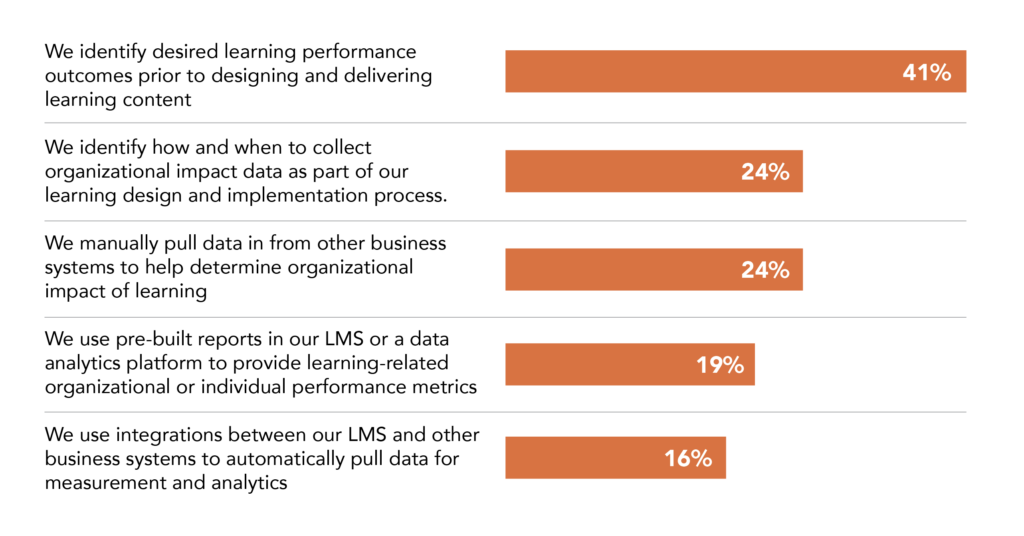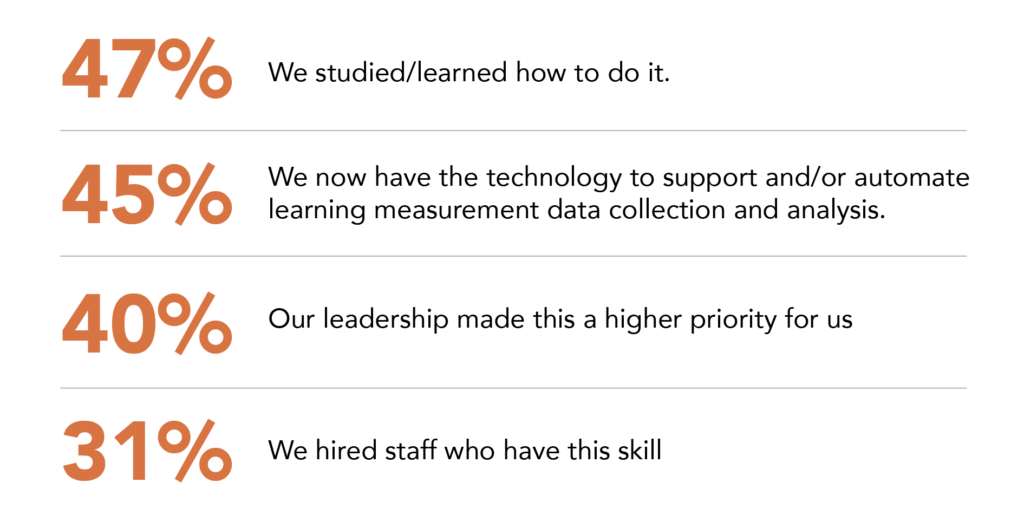Realizing the Business Benefits of Learning Analytics
Ask any learning professional about the quality of their learning initiatives and the contributions of their Learning team and they will gush.
Ask them how they know the learning programs are positively impacting the business and you often usually get a blank stare, followed by a vague response such as “We’re working on that.”
Learning analytics allow companies to improve training efficiency, maximize skill development, enhance employee experience, increase productivity, and drive better business performance. By linking learning data to critical business metrics, organizations can quantify the ROI of training initiatives and make data-informed decisions around learning strategy and investments. The overarching goal of learning analytics is to use people-centric data to build a highly-skilled, engaged, workforce, and create competitive advantage.
Brandon Hall Group has researched how organizations measure and analyze learning every year since 2014. Sadly, the needle has barely moved. Our latest research shows that:
- Fewer than one-third of organizations have done anything to address their gap in understanding and practice as it relates to data and analytics.
- More than two-thirds have yet to progress beyond basic awareness of that need.
- And one-third of these same organizations are making data-driven or data-informed decisions in less than one of every four decisions.
Proficiency in Measuring the Impact of Learning
Source: Brandon Hall Group study, Think Like a CEO: How Learning Drives Business Impact
Proficiency = Rating of 4 or 5 on 5-point scale
The bottom line is this: L&D will not be seen as true business partners unless they can use data and analytics to prove their worth to the business. To hear success stories and get strategic guidance on how to measure L&D’s impact, register for this Oct. 12 webinar presented by Litmos and Brandon Hall Group™.
In our research, we asked organizations that improved their proficiency in learning analytics over the past two years what the impact has been:
- 59% said they are viewed as more of a strategic partner in their organizations.
- 52% said they are better able to improve learning initiatives after initial results.
- 44% said they can more easily define the success or failure of their learning initiatives.
The Business Benefits of Learning Analytics
When leveraged effectively, learning analytics can help deliver the following key business benefits, multiple research studies show:
- Improved learner experience. By analyzing large-scale data about how learners interact with and respond to different learning methods, organizations can gain a granular understanding of learner needs and preferences. This allows them to create more personalized, engaging, and effective learning programs.
- Increased L&D efficiency. Learning analytics helps identify learners who may need extra support, surface learner challenges in real-time and optimize resource allocation. This leads to lower training costs and fewer burdens on L&D teams.
- Enhanced talent development. Analytics uncovers which learning activities have the greatest business impact. Organizations can use this to tailor development initiatives to upskill employees in key competencies linked to growth.
- Better training outcomes. By tying learning data to business metrics, companies can quantify the ROI of learning programs. This helps optimize training content and delivery for optimal results.
- Reduced attrition. Learning analytics can detect employees who may be struggling or disengaged, allowing issues to be addressed promptly through training interventions or other initiatives. This promotes retention.
- Data-driven decision-making. With real-time analytics and insights, L&D leaders can make more informed, evidence-based decisions around training priorities, modality, budgets, and resources.
Here are real-life examples of the impact of learning analytics:
- By gauging learner sentiment and Net Promoter Score (NPS) toward training, an employer compared any satisfaction difference between live instructor-led and virtual training. This led to course adjustments and changes to the curriculum.
- By analyzing learning consumption data, a company identified learners who are at risk of incomplete certification. It created campaigns to encourage or incentivize employees to complete courses needed to complete certifications. This can improve skill and performance and can help with career growth.
- An organization used analytics to identify curriculum topics that learners frequently struggle to understand. Using the information, tailored support resources were added to improve outcomes.
How Learning Organizations Can Improve
The benefits of learning analytics are still out of reach for many organizations. Learning professionals are generally very comfortable collecting lower-level data. They tend to wear “smile sheet” feedback and completion data as badges of honor. Depending on the topic, they may even have test or quiz results they can point to for comprehension results. But L&D professionals are far less comfortable going deeper into whether training has actually had a positive impact on an individual’s performance. They are even less comfortable diving into training’s effect on the business as a whole.
What is holding them back?
- Nearly 40% of our research respondents said they don’t have the budget and/or staff, and 30% said they don’t have the technology to support that type of analysis.
- Nearly half of respondents said they’re still using old-fashioned Excel spreadsheets to help measure learning impact.
- Nearly two-thirds are also using Learning Management Systems
- A little more than one-third also incorporate advanced standalone analytics tools such as Tableau, Metrics that Matter and Power BI.
Our research does show some improvement in the proficiency of measuring the impact of learning on individual and organizational performance metrics: 27% said they are proficient or very proficient, compared to 16% two years ago — a 69% difference. This is what organizations did to make progress:
Source: Brandon Hall Group study,
Think Like a CEO: How Learning Drives Business Impact
So, having the right technology is important, as is improving the skills of current staff and hiring new people with data analytics expertise. Here are the skills your organization should focus on developing, according to multiple research studies:
- Data literacy. The ability to read, understand, question, and argue using data. This allows nuanced interpretation of learning analytics.
- Data visualization literacy. The skills to present insights through visuals like charts, graphs, and dashboards that summarize complex data.
- Analytics fluency. Familiarity with learning analytics techniques, metrics, tools and applications to formulate an effective analytics strategy.
- Critical thinking. Asking the right questions of data and thinking critically about what insights mean in a business context.
- Change management skills. The capability to turn analytic findings into real changes in learning strategy, content, or platform.
- Stakeholder engagement skills. Effectively conveying insights to diverse stakeholders to get buy-in for proposed learning changes.
- Privacy/ethics understanding. A strong grounding in data privacy, security, and ethical use, to ensure learning analytics are applied responsibly.
Building a team encompassing these varied skills is essential for organizations to maximize the power of learning analytics. Here are five other success strategies for improving learning analytics:
- Think Like a CEO. Learn to speak the language of business inside the language of learning. Your deliverables are the company’s deliverables and your team has a critical role to play in the success of the business in the long term. Learning impacts business results.
- Make your case for technology. Excel, which is still used for analytics by 46% of organizations, is not enough. Do your research and show how everything from a simple LMS to an advanced analytics tool can make a difference from start to finish.
- Know what you’re measuring. Your learning strategy should be the same across the organization. Make sure everyone is using the same systems and metrics. Otherwise, you’ll end up comparing apples to oranges.
- Measure more than once. One-and-done measurement of a class or course doesn’t cut it anymore. Show how learning helped employees go from point A to B to C, instead of just showing what happened at the finish line.
- Be in it for the long haul. Improving learning measurement and analytics takes time, especially if you don’t have the right skills and technology in place yet. Get started with a strategy and timetable and stick with it.
In short, an effective L&D strategy can’t survive in a vacuum. Even seemingly effective learning initiatives – with great learner feedback, high average quiz scores, and steady participation rates – require buy-in from leaders and decision-makers outside of L&D. And to get that buy-in and deliver the best possible learning experience, L&D needs to take a deeper dive into data that illustrates its business value. That’s where learning analytics come in. If you’re not sure where to start, join Brandon Hall Group™ and Litmos to explore success stories in measuring learning ROI on October 12. Register here to save your seat.







